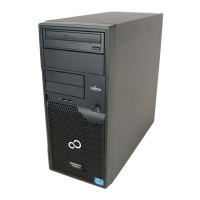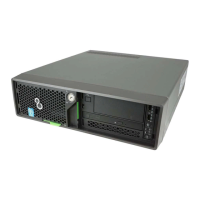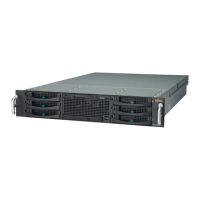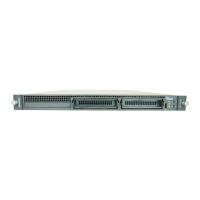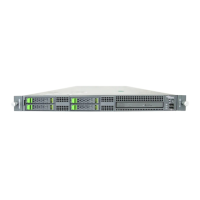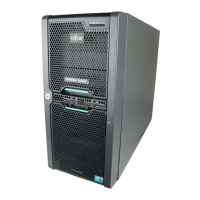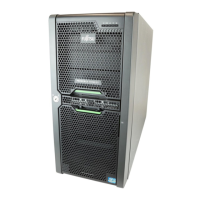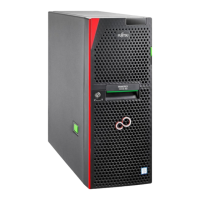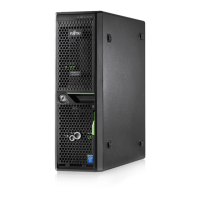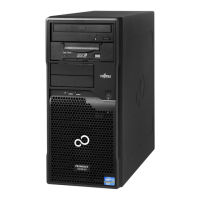
Do you have a question about the Fujitsu PRIMERGY TX100 S3 Core Edition and is the answer not in the manual?
Important safety information for using the product.
Information on potential radio interference from the device.
Details on limited-life components and their implications.
Explains intended use and limitations regarding high safety applications.
Recommendations to prevent issues from voltage drops.
Information on export/transfer controls for technology.
Conformance to harmonic current standard JIS C 61000-3-2.
Information on SATA hard disk drives for the Japanese market.
Describes the manual's purpose and intended audience.
Lists other documents and online resources related to the server.
Explains symbols, formatting, and warnings used in the manual.
Details the key features of the server, including processor and memory.
Describes drive bays, power supply, availability, data security, and server management.
Details the Maintenance & Recovery DVD for diagnostics and recovery.
Information on server maintenance and remote management capabilities.
Details system board, processor, and memory configurations.
Specifications for interfaces, onboard controllers, and expansion slots.
Details drive bays, operating panel, dimensions, and weight.
Covers ventilation clearance, ambient conditions, and noise levels.
Details electrical specifications like voltage, frequency, and current.
Lists safety, ergonomics, and electromagnetic compatibility standards.
Provides an overview of the server installation steps.
Critical safety guidelines and warnings for handling the server.
CAUTIONary notes before initial startup and installation.
CAUTIONary notes regarding installation and operational environment.
Safety guidelines for power connections, cables, and electrical hazards.
Safety instructions for system operation, component installation, and warranty.
Precautions for handling Electrostatic-Sensitive Devices (ESDs).
Guidelines for safe handling, replacement, and disposal of batteries.
Instructions and CAUTIONs for using optical drives and media.
Information about the laser class of the optical drive and associated safety.
Identifies ESD sensitive components and handling procedures.
Information on ENERGY STAR compliance and factors affecting it.
Details CE marking and relevant EU directives.
FCC and ICES compliance statement for Class A digital devices.
CAUTIONary instructions for transporting the server safely.
Information on environmentally-friendly design, energy saving, and packaging.
Guidance on disposing of consumables like batteries.
Information on battery disposal and recycling according to EU directives.
Procedures for returning, recycling, and disposing of the device according to WEEE.
Safety guidelines and acclimatization requirements before server installation.
Steps for unpacking the server and checking contents for damage.
Guidelines for server placement and environmental/spatial requirements.
Instructions for connecting external devices to the server's ports.
Steps for connecting the server to power and securing the cord.
Important considerations and procedures for connecting/disconnecting cables.
Steps for opening the server chassis to access internal components.
Identifies and explains the server's front panel controls and indicators.
Explains the function of control elements like the On/Off button.
Describes the behavior of power and HDD activity indicators.
Explains the LAN link/transfer and speed indicators on the rear panel.
Information about the push button mains switch and Zero Watt concept.
Ensures the server is connected to the network for remote access.
Instructions for powering on the server and initial boot process.
Details methods for connecting to the server by name or IP address.
How to connect using the default computer name.
How to connect using the server's IP address and network configuration.
Steps to launch and use the Remote Desktop Connection client.
Guides through completing the OS setup via Initial Configuration Tasks.
Steps to change the operating system's language settings.
Optional steps to configure network settings for the server.
How to set the server's computer name and join a domain or workgroup.
Instructions for activating the Fujitsu AIS Connect service.
Guide to establishing a VNC connection for server access.
Overview of the Maintenance and Recovery Manager interface.
Details functions within the Maintenance section of the manager.
Details functions within the Recovery section and the help function.
Steps to use PrimeCollect for gathering diagnostic data.
Overview of methods for recovering or resetting the server.
Procedure to reinstall the operating system while preserving data.
Procedure to restore the server to its original factory settings.
Steps to configure the server's onboard SATA controller.
Instructions for shutting down and alternative power management methods.
Guidelines for safely cleaning the server.
Methods for securing the server to prevent removal from its location.
Troubleshooting steps if the power-on indicator is off or shows errors.
Solutions for date/time, optical drive, and defective drive problems.
Troubleshooting for inaccessible services and unexpected server shutdowns.
How to resolve errors reported by ServerView Operations Manager.
Troubleshooting steps if the server unexpectedly switches off.
Steps to resolve issues with establishing a Remote Desktop connection.
Troubleshooting steps when a VNC connection cannot be established.
Procedure for OS recovery with 4 HDDs, preserving data on specific drives.
Troubleshooting steps when the power-on indicator shows a high-frequency error.
Troubleshooting for low-frequency power LED flashes indicating boot failure.
